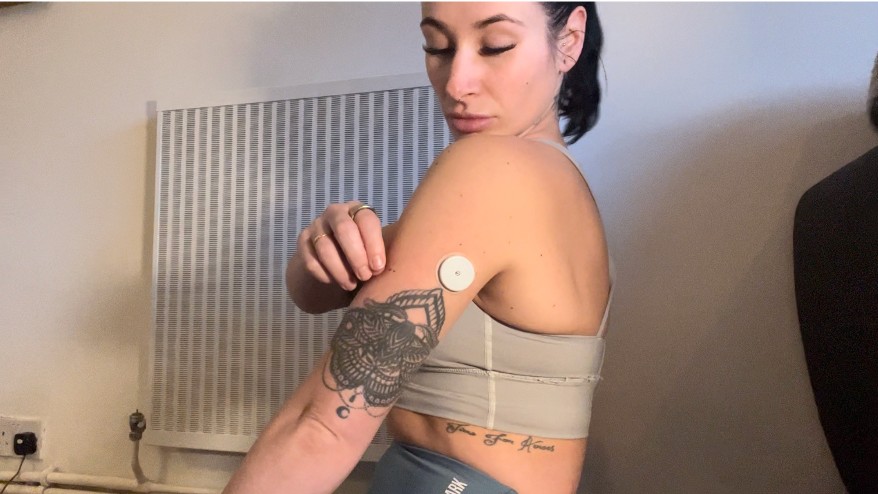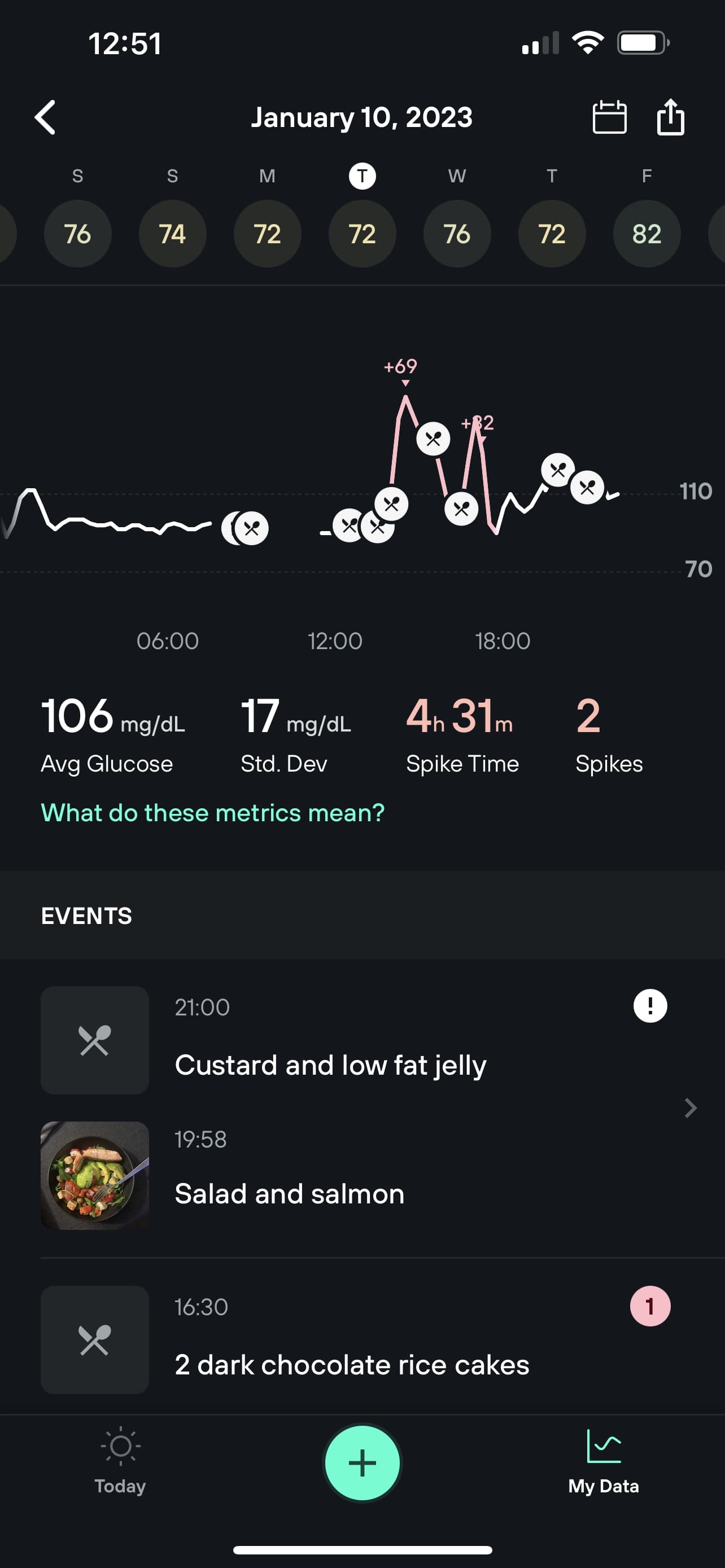
I’d heard of continuous glucose monitors (CGM), devices designed to monitor your blood glucose. But I didn’t realize how powerful they could be as a tool for understanding energy levels, workouts, and overall metabolic health — until now.
Over a month ago, I began testing the Levels Health continuous glucose monitor to understand the effects my diet and activity choices have on my glucose levels and health, in real-time. Typically these devices were for people to track blood sugar at a glance, helping those with chronic lifelong health conditions like diabetes balance factors like food and physical activity more effectively.
But more recently, biohacking has become all the rage: the ability to “hack” various aspects of your mental and physical health to improve performance using DIY biology. It might sound like superhuman enhancement, but some listed methods include intermittent fasting and cold water therapy. And now CGMs are being used to hack metabolic health.
Ever the curious journalist, I wanted to find out what happened when I used a CGM to monitor my glucose levels. Here’s what I learned.
Blood glucose and insulin
A quick crash course. The CDC explains that insulin (a hormone produced by the pancreas) regulates blood glucose levels. If you lack insulin, or your body isn’t responding to it (known as insulin resistance), blood sugar levels could stay elevated for prolonged periods, increasing your chances of developing diabetes. The research explains that insulin regulates how the body uses and stores glucose, taking it from the blood to be used by the cells in your body for energy.
Insulin also gives your liver a nudge, telling it when to store blood sugar. When blood sugar levels get too low, the liver can release stored blood sugar to use, but some people's bodies manage this process better than others.
Metabolic health

Your metabolic health regulates everything from sleep and weight to your energy levels. Poor metabolic health can lead to fatigue, weight gain, or chronic health conditions. But changes in the gut microbiome are also associated with metabolic disorders like diabetes when the body struggles to maintain stable glucose levels. We cover everything you need to know about metabolism and metabolic health here — slow metabolism? This could be the secret to better workouts.
Get instant access to breaking news, the hottest reviews, great deals and helpful tips.
What is continuous glucose monitoring?
As summarized by the National Institute of Diabetes and Digestive and Kidney Diseases, a CGM monitors your blood glucose (blood sugar) and tracks trends as they develop. They help you make better choices, sensing if your body is reaching dangerously high or low levels and sounding the alarm.
High blood sugar levels (hyperglycemia) measure above 48 mmol/mol and could result from prolonged stress or lifestyle factors like sleep, diet, and poor metabolic health. It puts people at a higher risk of developing chronic conditions but is common in people who already have diabetes.
Low blood sugar — hypoglycemia or a “hypo” — could result in shakiness, dizziness, and a rapid heartbeat. Anyone can suffer from low blood sugar, but diabetics find that intense exercise or skipping a meal could bring it on. The Levels Health CGM uses a small needle-like sensor under the skin that measures your glucose using biosensors that send data directly to your smartphone, sending insights to improve your choices and boost your metabolic health.
I tested the Levels Health continuous glucose monitor — here’s what happened
Here’s what happened when I used the Levels Health CGM for one month.
It’s easy to set up, but a bit bulky to wear
These devices are super helpful for people managing chronic health conditions, so it’s nice to know they’re easy to use, although (frustratingly) not yet financially viable for everyone. The Levels CGM is currently in beta, and I was very lucky to be one of less than five UK testers in this phase.
The Levels CGM device comes with several changeable protective patches, an applicator, and two downloadable apps — Levels and the device scanning app LibreLink. You can sync apps so that every time the user scans the CGM on the LibreLink, data transfers to Levels, where all your stats and feedback are stored. That said, I must’ve knocked the device on my arm off every door frame in London, and it felt bulky to wear on the back of my arm during training.
That aside, to scan your CGM, simply open the app, hit "scan" and hold your phone camera over the CGM on your arm. Done.
It’s overwhelming
Unlike popular food tracking apps like My Fitness Pal, Levels requires you to manually scan, sync, and then enter each meal and take a photo or use dictation to describe food items. It can remember previous data, but it’s far from the quick and intuitive method used with MFP. The app is still in beta, and Mike Didonato, a founding team member at Levels, explained that an AI rollout and auto-scanning are underway.

I found the process time-consuming as I already use several apps — the Oura ring and Natural Cycles — that require daily manual data logging. I felt like I’d just voluntarily doubled my admin. As a caveat, the more data you feed the app and scan your CGM, the easier it becomes. They say it takes 66 days to build a habit, after all.
The data and graphs were confusing, but Didonato advised only using LibreLink to scan and Levels for everything else. You can look at the day view (all stats for that day), add meals, and hit the data tab for trends, insights, and scan history in one place.
However, you have to scan your CGM every eight hours or lose the data for that period — something I frequently experienced as I kept forgetting. If you consider yourself a data junkie, the app also connects to Oura and Apple Health to track the effects of sleep and workout data on your blood sugar.
It was eye-opening
Levels app reports spikes and crashes, the time recorded, and a suspected cause. It then generates insights to help you improve your experiences. For example, I was offered recipes for a healthier snack option (what do you mean, malt balls don’t count?) that should help stabilize blood sugar.
You’re advised to stick to your regular routine during week one and only start “playing around” with your diet in the second week before implementing what you’ve learned in the third. Although we’re advised “this food is good” or “this food is bad,” the Levels CGM taught me that your response to stimuli is unique. What I might consider healthy (a salad, for example) might send my blood sugar soaring, whereas a croissant which “should” have negatively impacted me, didn’t. Is the device broken?
Nope. The experience is different for everyone. Your gut microbiome is unique and relates to how you metabolize your food. Sleep, time of day, exercise — all these factors could affect how you respond. Moreover, high-intensity exercise like weightlifting can send your blood sugar soaring due to the release of hormones like adrenaline that raise glucose levels.
It’s a sentiment echoed by Levels, who said, “your favorite “healthy” foods may be holding you back. With Levels, you can adjust what, when, and how you eat for better mental clarity and athletic performance, to stay energized throughout your workouts, and fuel your body properly.”
My blood sugar was a mess
Levels over 30 mg/dL, and exceeding 110 mg/dL, are considered a spike that can lead to brain fog and cravings — something I regularly suffer in the late afternoon. A prolonged spike indicates an uncontrolled metabolism, and your variability refers to how often these spikes and crashes occur — a low variability is an indication of a more stable metabolism.

My blood sugar spiked an alarming amount — sometimes it would be due to something I considered “good” like a protein smoothie. The app would flag a logged meal and let me know what had likely caused it, followed by how long my levels had been stable or unstable. I experienced several spikes and crashes a day, often late in the afternoon or early in the evening, which explained my yawn marathons every day.
I’ve started to slowly change out the snacks I consume at this time, which has helped me feel more energized and less up and down. While I thankfully don’t need to strike off carbs, I (personally) prioritize them earlier in the day and consume protein and fibrous food alongside them to balance me out.
I made healthier choices
It’s an investment in the long run, and although I’ve managed to even out some afternoon spikes, and afternoon fatigue has slightly reduced, it’s not an overnight fix.
I consciously made better choices because I felt accountable when logging, but I can see how this could be problematic for people navigating a tricky relationship with food. Food tracking is emotionally complex, so I recommend anyone in this situation think carefully and consult a medical professional before making any decision.
Moreover, there are plenty of ways to boost your metabolism without dieting, and it takes some experimentation.
The gut matters
I don’t recommend counting calories to optimize health. Much of the current research has shown that your gut health is the control hub for indicating the quality of your metabolic health, immunity, and weight control.
Research led by genetics professor Tim Spector found that when measuring the gut health of genetically identical twins, the diversity of their individual gut microbiome was a crucial indicator of differentiating health markers and metabolism. Moreover, the research could help measure metabolic responses to meals based on your microbiome profile.
A diverse gut is a powerhouse, with these tiny bugs controlling many cellular processes in the body. Levels help you to improve metabolic flexibility — how well your body switches between fat and glucose — which can keep your energy more stable in the gym. Alongside stable glucose, you can optimize your metabolic health.
Verdict
Levels introduced me to my gut health deeper, helping me understand how food, metabolism, and exercise all play a role. I could see the benefit of everyone using a CGM to monitor their long-term personalized metabolic health, but is the process streamlined enough yet? I’m not sure.
Looking for other ways to improve your metabolic health? One writer used a Lumen to track metabolism, and this smart ring offers ultrahuman fitness tracking.

Sam Hopes is a level 3 qualified trainer, a level 2 Reiki practitioner and fitness editor at Tom's Guide. She is also currently undertaking her Yoga For Athletes training course.
Sam has written for various fitness brands and websites over the years and has experience across brands at Future, such as Live Science, Fit&Well, Coach, and T3.
Having coached at fitness studios like F45 and Virgin Active and personal trained, Sam now primarily teaches outdoor bootcamps, bodyweight, calisthenics and kettlebells.
She also coaches mobility and flexibility classes several times a week and believes that true strength comes from a holistic approach to training your body.
Sam has completed two mixed doubles Hyrox competitions in London and the Netherlands and finished her first doubles attempt in 1:11.
